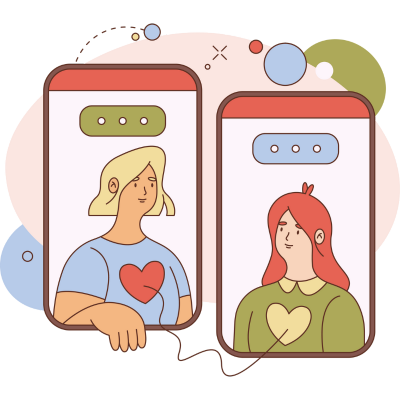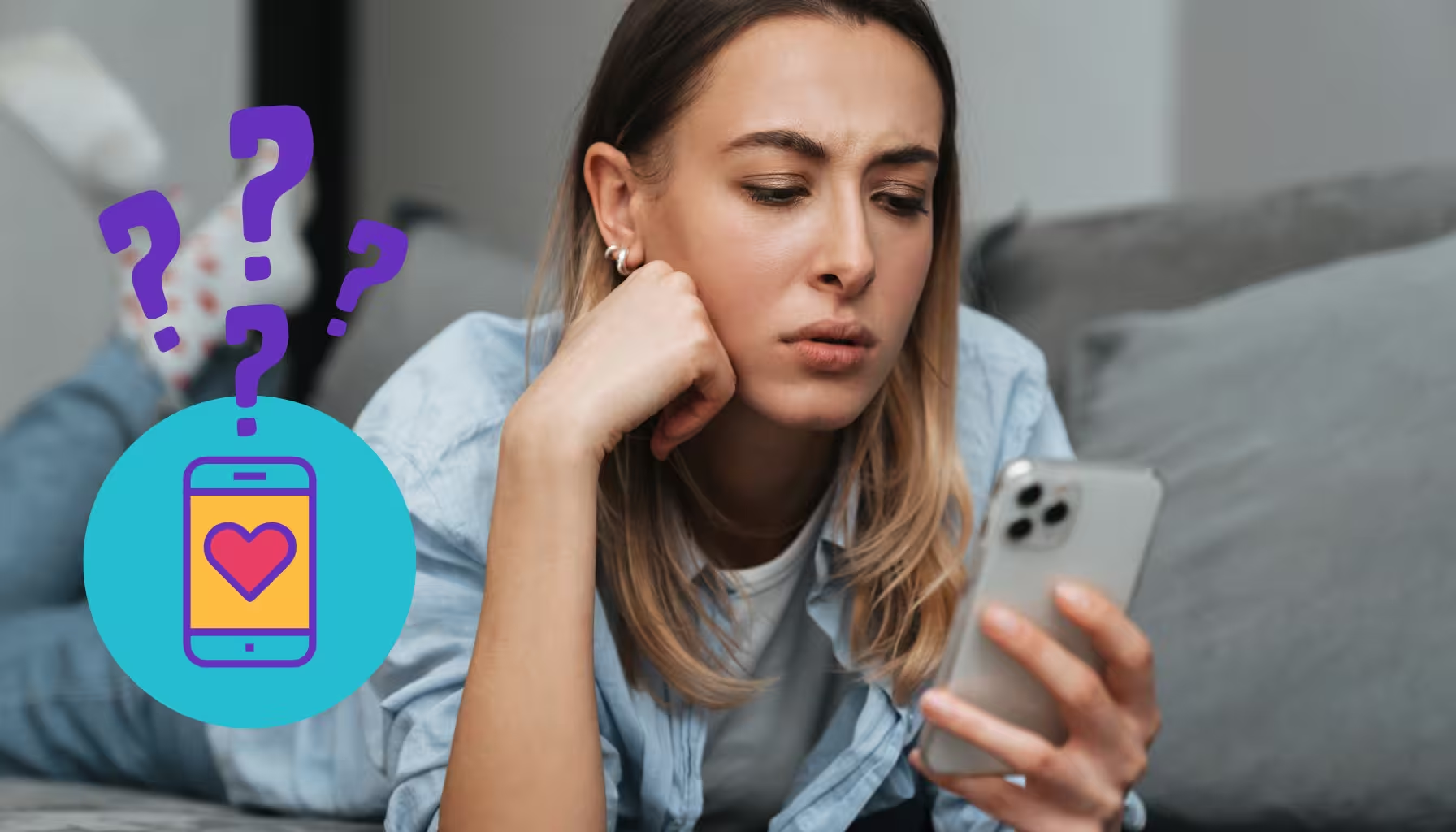We all (okay, maybe not all of us, but a lot) spend way too much time with our eyes glued to our screens. Either we are mindlessly watching TikTok videos instead of going to bed (that’s me), scrolling through social media to catch up with what’s trending or catching up on the latest Facebook gossip, binge-watching shows on Netflix or Hulu, or texting away on our phones.
Have our devices become an extension of our hands? Sure seems like it! And if you tried to take someone’s phone away, they may physically fight you (also me). That means some of us are a little too attached to our gadgets. When was the last time you made it an hour without checking your phone? And no, sleeping doesn’t count!
Don’t get us wrong, having the world in the palm of our hands is amazing. But there’s a huge difference between staying in touch and getting totally sucked into the digital ether. We are hardwired to need human connection, and FaceTime calls just don’t cut it.
No amount of double-tap hearts on Instagram or emojis replaces the feeling of actually being with another person IRL, laughing, talking, and just being with another human. As with everything, there needs to be a balance—yes, you can still have screen time and enjoy the perks, but you have to counteract it with human contact.
Being aware of how much time you’re spending online is half of the battle: once you do that, you can dial it back and make sure there’s enough time for the real stuff in the real world.
Do you need a digital detox? Keep reading to see if you need to reassess how much time you spend staring at screens instead of real-life interactions!
The Impact of Excessive Screen Time
Screens have become a core part of our daily routine. From your work day to catching up on social media and the shows you watch, they’re always in front of you, next to you on the couch, or in your hand while you’re on said couch.
Yes, it’s convenient, but there’s a sinister side to this screen obsession that slowly creeps up on us, and it affects our minds, bodies, and relationships. How does all of this screen time actually affect us?

Mental and Physical Effects of Constant Screen Use
We all know what the immediate discomforts of too much screen time are: tired eyes, a stiff neck, and possibly a headache—it turns out these physical symptoms are just the tip of the iceberg. Long-term exposure can cause more severe issues!
When you stare at a screen for hours, your blink rate drops, causing dry eyes and possibly prolonged discomfort that eye drops won’t fix. Then there’s the unnatural position of being hunched over a laptop or phone, which can result in chronic neck and shoulder pain and, in some cases, serious conditions like carpal tunnel syndrome.
On the mental front, constant screen exposure can be really harmful—one of the most alarming effects is on your sleep pattern. The blue light emitted by screens messes with your body’s ability to produce melatonin, the hormone that’s responsible for sleep regulation.
As a result, screen users might have poor sleep quality, which can add to mental health issues like anxiety and depression. Studies have also shown that excessive screen time may actually alter the brain’s structure, causing the cerebral cortex to thin, which affects memory, decision-making, and problem-solving *gulp*.
The mental toll doesn’t stop there, oh no. The constant stream of info and stimuli from screens can overwhelm your brain, resulting in shorter attention spans, impaired memory, and a general sense of mental fatigue.
Over time, this can lessen your ability to focus on tasks that require your attention, making everyday things harder—and frustrating.

How Digital Overload Strains Real-Life Relationships and Social Connections
When screens take over our lives, real-life connections tend to take a backseat. It’s super easy to get caught up in social media or online stuff and forget to be present or engage with the people around us. This distraction can weaken relationships, making it harder to connect with people on a real level.
Being physically present but mentally elsewhere, thanks to a screen causes a breakdown in communication. Sure, you’re nodding along to a friend’s story but are you really listening? Or even worse, you could be missing out on important moments with loved ones. In the long run, small disconnects add up, possibly causing feelings of loneliness and isolation even when you’re in the same room as others.
Another issue is the way social media can warp our perceptions of reality—the curated perfection of other people’s lives online can cause feelings of inadequacy or jealousy, which can further strain relationships. Comparing yourself to others based on their online personas might turn into resentment and insecurity, making it hard to sustain healthy relationships.
Most importantly, spending too much time on screens robs you of the chance to build and strengthen real connections. True relationships necessitate time, effort, and presence—things that are in short supply when you’re constantly distracted by your devices. Either you are missing out on good conversations or simply not being totally present while spending time with someone, but no matter the result, the impact of digital overload on your social life is really hard to ignore.
What is a Digital Detox?
In a hyper-connected world, it’s not difficult to let screens dominate our daily lives. From the moment we wake up to the time we go to bed, a lot of us have all eyes on our devices. Notifications, social media, streaming services—our screens give us a constant source of entertainment, info, breaking news, and connection.
But there’s a catch—when the digital world starts to feel like you’re doom scrolling or when it takes us away from the things that actually matter, it might be time to think about taking a little digital detox. This doesn’t mean you are going Amish and shunning technology; you are just recalibrating how you interact with technology and reclaiming some space for yourself.

Definition and Purpose of a Digital Detox
A digital detox involves intentionally disconnecting from digital devices such as smartphones, computers, tablets, and televisions for a set period. Think of it as a juice cleanse but for your brain and psyche. It can be anything from a few hours to a few days, depending on your goals and what your digital habits are.
The purpose of this break? To decrease stress, improve mental clarity, and reconnect with the physical world around you. It’s a chance to give your brain a break from the constant input that screens provide and to focus on the things that nourish your mind and body.
The benefits of a digital detox can be boundless—by looking away from screens, you can improve your mental health, improve your relationships, and get a whole new perspective on how technology fits into your life! It’s not about cutting out technology entirely but rather finding a healthier balance that lets you enjoy its benefits without becoming totally entrenched.

Common Signs You Might Need a Break from Screens
If you’re wondering if a digital detox might be right for you, here are some signs that it could be time to cut back on your screen time:
- Persistent Anxiety or Irritability: If the mere thought of being without your phone makes you uneasy, or if you find yourself hitting the roof every time your phone dings with a notification, this is a pretty good sign that your relationship with your devices has become too intense. The constant barrage of info and demands for your attention can make you feel frazzled and unable to relax.
- Sleep Issues: Struggling to fall asleep at night? Your screen might be to blame! The blue light emitted by phones, tablets, and computers is said to interfere with the production of melatonin, the hormone that helps regulate sleep. If you’re not getting the rest you need, a digital detox could help reset your sleep patterns.
- Decline in Social Interactions: While screens keep us connected in lots of ways, they can also create a barrier between us and the people physically around us. If you find yourself more engaged with your phone than with your friends or family, or if you’re starting to avoid in-person interactions in favor of digital ones, it might be time to reassess your habits.
- Decreased Focus and Productivity: Constantly checking your phone or getting sidetracked by notifications makes it hard to stay focused on important tasks. If you find it difficult to concentrate at work, school, or home, reducing your screen time could help you regain your focus and boost your productivity.
- Physical Discomfort: Eye strain, headaches, and “tech neck” are all common complaints among those who spend too much time in front of screens. If you’re experiencing any of these symptoms, it is a sign that your body is telling you to take a break.
- Negative Impact on Self-Esteem: Social media is something that only highlights the best bits and pieces of people’s lives, but it can also result in negative emotions like inadequacy or jealousy. If you find that scrolling through your feeds leaves you feeling worse about yourself, a digital detox can give you the mental space needed to regain a healthier perspective.
Taking the time to unplug can be incredibly refreshing, allowing you to reconnect with the world around you and find a more balanced approach to technology.
Practical Tips for a Digital Detox
Have you ever been on your phone and realized it’s 2 am when you swear it was 10 pm and you’ve only been looking at Reddit for 15 minutes? Hours can pass, and you have almost no recollection of it. That’s how sneaky screen time can be!
They pull us in and hold our attention for way longer than we intended. It can take over our lives if we’re not super careful, and that’s where a digital detox comes in handy. You don’t have to be dramatic about it and throw your devices in the garbage, but you should at least consider creating healthier habits that put you back in control.
How? By doing the following!

Setting Boundaries: Time Limits and Screen-Free Zones
Creating boundaries around your digital use is one of the most successful ways to manage your screen time. Here’s how you can set up these boundaries in a way that fits your specific lifestyle:
- Time Limits: Start by figuring out how much time you’re currently spending on your devices. All smartphones have features that track your usage, giving you solid data of exactly how much time you’re dedicating to different apps or activities. Once you know where your time is going, set limits for yourself. Maybe it’s no more than 30 minutes of social media per day or restricting TV watching to one episode of a show in the evening. The idea is to be conscious of your digital consumption and to keep it within limits that feel manageable and healthy.
- Screen-Free Zones: Designate certain areas in your home as off-limits for screens—keeping the bedroom free of electronics can improve your sleep quality. When you take away the temptation to check your phone before bed, you will wind down more naturally. The dining room is another great place for a screen-free zone. It encourages better interactions during meals so that everyone is present in the moment.
- App Management Tools: Use the built-in features on your devices to help enforce these boundaries. Smartphones have options to set app limits or schedule downtime, which can be super helpful if you find yourself mindlessly scrolling through apps. These tools are reminders to put the phone down and do something else.
- Evening Curfews: Establish a rule for yourself that all screens are turned off at least an hour before bedtime. This gives your brain time to disconnect from the digital world and get ready for rest. Instead of scrolling through your phone, use this time to do more relaxing activities like reading a book.

Incorporating Hobbies and Offline Activities
Once you’ve set your screen time boundaries, it’s important to fill that reclaimed time with things that make you happy! Below are some ways to incorporate more offline activities into your life:
- Reconnect with Old Hobbies: Think about the things you used to love doing before screens took up so much of your time. Maybe it was painting, knitting, playing an instrument, or just hanging out with friends (phone-free). These activities are not only fun but also give a sense of accomplishment that scrolling through social media can’t match.
- Explore New Interests: If you’re looking for something new, think about picking up a hobby that doesn’t involve a screen. It could be anything from learning a new language, learning to play tennis or pickleball, or taking up photography with an actual camera instead of your phone. The point is to find something that excites you and can become part of your daily or weekly routine.
- Get Active: Physical activity is an excellent way to disconnect from screens and connect with your body. Take a yoga class, go for a run or a walk, or hit the gym—regular movement is important for both physical and mental health. Spending time outdoors also has the added benefit of improving mood and decreasing stress.
- Socialize in Person: Make it a point to spend more time with friends and family in person rather than just chit-chatting over text. Plan things that require face-to-face interaction, like nights out or just catching up over a latte. Real-world interactions are a must for strong relationships and improving your overall well-being.
- Practice Mindfulness: Mindfulness practices, like meditation or deep breathing exercises, can help you become more aware of your screen habits and more intentional about your digital use. Both encourage you to focus on the present moment and can be a great way to center yourself, lessening the urge to reach for your phone out of boredom or habit.

Scheduling Tech-Free Times: Digital-Free Mornings, Weekends, or Vacations
Regularly scheduled breaks from technology can help you have a much healthier relationship with your devices. How? Easy! Build tech-free times into your routine!
- Digital-Free Mornings: Starting your day off without screens sets a positive tone for the rest of the day. Instead of reaching for your phone as soon as you wake up, try beginning your day with things like stretching, reading the newspaper (yes, they still exist), or just having a cup of coffee. This eases you into the day with a clear mind rather than being immediately bombarded with info and notifications.
- Tech-Free Weekends: Pick one day a week to go completely offline. This is hard, but it’s also incredibly refreshing. Use this day to do things that you love but don’t usually have time for during the week! It could be spending the day outside, reading a book, or just chilling without the distraction of screens. Tech-free days are self-care days.
- Digital-Free Vacations: Think about taking a vacation where you limit or completely eliminate your use of digital devices. Leaving your devices behind means you can fully immerse yourself in the vacay. Without the constant pull of screens, you can relax and actually take in and enjoy your surroundings and the people you’re with.
- Boundaries During Work: If your job requires you to be online, it’s important to set boundaries around your screen use during work hours. Take regular breaks to walk away from your computer, and make sure you have a clear end to your workday. You could decide that after 6 pm, all work-related emails and messages can wait until the next day. This helps you create a better work-life balance and prevents burnout.
- Involve Others in Your Detox: Doing a digital detox with friends or family can make it easier and more successful—there’s strength in numbers, so plan some tech-free outings together! Plus, the support of others will make it easier to stick to your goals.
Reconnecting with Real-Life Relationships
Technology makes it easier than ever to stay in touch, but it also can create a sense of distance, even when we’re constantly connected. The warmth of face-to-face interactions is something digital communication can’t replace.
Reconnecting with loved ones in person can rekindle relationships and strengthen bonds in ways that text messages and video calls just can’t. Below is why spending quality time together in person matters, how practicing mindful communication can improve those connections, and some fun ways to spend time with those who matter the most to you!

Benefits of In-Person Interactions
There’s something uniquely powerful about being in the same room as someone you care about. Face-to-face communication goes far beyond words—it includes body language, facial expressions, and even the energy you bring into the interaction. These elements all contribute to a richer, more authentic connection.
Studies have shown that people who prioritize in-person interactions tend to be happier and experience better mental health. The physical presence of another person helps fulfill our innate need for social connection, which is a must for emotional well-being. Real-life interactions allow for spontaneous, unscripted moments that can strengthen relationships in ways that digital communication cannot!

Mindful Communication: Focusing on Quality Time with Loved Ones
Mindful communication means being totally present in your interactions and giving your complete attention to the person you’re with. This sounds easy enough, but in a world filled with distractions, it’s a skill that takes practice!
To practice mindful communication, start by eliminating distractions during conversations. This means putting away your phone, turning off any background noise, and focusing solely on the person in front of you. This gesture shows that you appreciate the other person’s presence and are fully into what they have to say.
Active listening is another big part of being present—instead of thinking about how you’ll respond or waiting for your time to talk, focus on taking in what the other person is saying—both their words and the feelings that are behind the words. This not only shows that you care, but it also means you will respond in a much more thoughtful and considerate way.
Open and honest communication is also a necessity—communicating your thoughts and feelings in a way that is respectful of the other person’s emotions makes a space where both people are comfortable being themselves, leading to a stronger bond!
Spending time together doesn’t have to be a complicated affair or involve making elaborate plans. What matters most is the quality of the time you spend together and the things that let you connect on a better level. Stuck for ideas? We gotchu!
- Hit Up a Live Performance: Go to a concert, a play, or a stand-up comedy show—live performances are always a good time!
- Join a Book Club: If you and your friends or family members love to read, why not start a book club? Choose books that interest everyone and meet up to discuss them.
- Volunteer Together: Working on a cause you both care about can strengthen your bond while making a positive impact on the community. Donate your time to a local food bank, do a charity run, or volunteer at an animal shelter. Volunteering is a worthy cause and gives people a feeling of shared purpose while helping those in need.
- Host a Game Night: Board games and card games are so great for bringing people together in a fun and interactive way. They encourage teamwork, friendly competition, and lots of laughs, making them perfect for family gatherings or nights with friends.
- Take a Class Together: Learning something new as a team can be fun and rewarding. Doesn’t matter what it is—finding out you have a skill you didn’t know you had or are terrible at something, you can still have fun while you bond!
- Take a Day Trip: Escape the daily grind by exploring a new town, going to a nearby beach, or taking a scenic drive. These little adventures give you a change of scenery and time to reconnect away from daily distractions.
- Plan a DIY Home Project: Collaborating on a home improvement project—like building a garden, painting a room, or assembling furniture (not IKEA furniture, that could cause an argument among even the most solid relationships)—is both productive and fun. It’s a chance to work together, problem-solve, and then beam with pride at the results of your joint effort.
- Take Part in a Community Event: Check out local community events like festivals, block parties, or neighborhood clean-ups. These activities allow you to socialize with your local community while spending time with loved ones, and they can widen your social circle!
- Try a New Sport or Physical Activity: Whether it’s trying out tennis, learning to kayak, or taking a spin class, taking part in a new physical activity can be a fun challenge. It’s a great way to stay active while also encouraging teamwork and cooperation.
- Go on a Mystery Adventure: Plan a day where you surprise each other with activities. One person plans the morning, and the other plans the afternoon, but neither knows what’s in store for the other!
- Host a “No-Talking” Challenge: Spend an hour or more doing things together without speaking. This could be anything from gardening to cooking or even just sitting quietly together. The lack of verbal communication forces you to connect in other ways.
- Go to a Silent Retreat: If you’re looking for something that’s even more immersive, you could hit up a silent retreat together. These retreats are a way to connect without words, focusing on presence, mindfulness, and mutual support.
Finding a Sustainable Balance
Our phones and devices keep us connected, informed, and entertained, and while technology absolutely makes life easier, it can also cause a disconnect—from ourselves, from our loved ones, and from the world around us. That’s why striking the right balance between digital engagement and real-life connection is so important!
You don’t have to abandon technology totally—just use it in a way that adds to your life instead of detracting from it. Below is how you can integrate digital tools mindfully, build better screen habits, and regularly check in with yourself to make sure your digital life isn’t swallowing you whole.

Integrating Digital Tools Without Losing Real-Life Connection
Technology should be a thing that improves our lives, not something that dominates them, so we should be intentional with how we use our devices. Yes, a smartphone helps you stay in touch with friends and loved ones, but it shouldn’t replace the interactions you have with those who are physically close to you.
- Set Boundaries: Create specific times and spaces where technology is off-limits. This could be a “no phones at dinner” rule or designating the bedroom as a screen-free zone.
- Prioritize Real Interactions: Make an effort to have face-to-face conversations whenever you can. Use technology to arrange meetings, not as a substitute for them.
- Be Present: When you’re spending time with others, put your devices away and give them your full attention. The simple act of putting your phone in your bag or in your pocket strengthens your relationships and makes your interactions more meaningful.

Building Healthy Screen Time Habits in Daily Life
Developing healthier screen habits doesn’t have to be hard—making a few small, manageable changes can do the trick:
- Track Your Screen Time: Use built-in tools on your devices or download apps that monitor how much time you spend on screens. Knowing where your time goes is the first step in making any necessary changes.
- Set Specific Limits: Once you know your usage patterns, set limits on how much time you spend on certain activities, like social media or video games. These limits can be daily or weekly, depending on what works for you.
- Schedule Regular Breaks: Break up your screen time by taking short breaks throughout the day. Stand up, stretch, or go for a quick walk. These breaks are important for both your physical and mental health.
- Establish a Digital Curfew: Shut down your devices at least an hour before bed to avoid the blue light that can interfere with your sleep. Instead, wind down with a book, a bath, or maybe some light stretching.
- Create Tech-Free Zones: Designate areas in your home where screens are not allowed, like the dining room or the bedroom. This helps create spaces for relaxation and connection without digital distractions.
- Avoid Multitasking: Focus on one task at a time rather than trying to juggle multiple things at once. This improves your productivity and lessens the stress that comes from being constantly distracted.

Evaluating Digital Habits Regularly
Doing an assessment of your digital habits every so often is really important to have a healthy balance between your online and offline lives. The following is how to keep your digital use in check:
- Do a Digital Audit: Every so often, take a step back and evaluate how you’re spending your time online. Are you using your devices in ways that align with your goals and values, or are you getting sucked into mindless scrolling?
- Go Offline: Periodically disconnect from your devices for a day, a weekend, or even longer. These breaks can help reset your habits and give you a fresh perspective on your digital life.
- Declutter Your Digital Space: Just like physical clutter, digital clutter can weigh you down. Unsubscribe from unnecessary emails, delete apps you don’t use and organize your files. A clean digital space can make your online experience more focused and less stressful.
- Think About Your Digital Detox: After trying out new habits or doing a digital detox, take some time to think about how you felt. Did you notice any changes in your mood, productivity, or relationships?
- Reassess Your Boundaries: As life changes, so too might your relationship with technology. Regularly check in with yourself to see if your current boundaries are still serving you, and make any necessary adjustments.
Conclusion
Let’s keep it 100—technology isn’t going anywhere, and truth be told, none of us want it to. But that doesn’t mean it should be the boss of us! Finding a good balance between our digital lives and our real ones is like perfecting the art of making a great sandwich—you need just the right amount of everything. Too much mayo (screen time), and you might get queasy. Not enough, and it won’t be as good.
A little digital detox here and there doesn’t mean you’ll turn into a tech-hating hermit; it’s giving your brain a break, reconnecting with what and who really matters, and making sure you’re living life, not just living vicariously through other people on your phone.
So, put down the phone, look up, and realize that the world is still turning with or without a decent Wi-Fi connection. The best connections are the ones you make face-to-face—no network or aux cord is needed.
Finding a good balance between screen time and real-life connections isn’t just about feeling better in the short term—it’s like investing in a happier, healthier future.
When you make time for genuine face-to-face interactions, you’re nurturing relationships that can lift you up when life gets tough. Plus, cutting back on endless scrolling and binge-watching gives your brain a chance to recharge, which means less stress, better sleep, and a clearer mind. And let’s be honest, life’s just more fun when you’re actually living it, not just watching it unfold on a screen.
You don’t have to swear off technology to start seeing the benefits—it’s little changes that can add up. Try leaving your phone in another room during meals or setting aside some time each day to be fully present with the people around you.
Even small changes will open up space for the kind of interactions that make life better. The more you do it, the more you’ll appreciate real-world connections—and you never know; you could end up liking them more than being chronically online!




